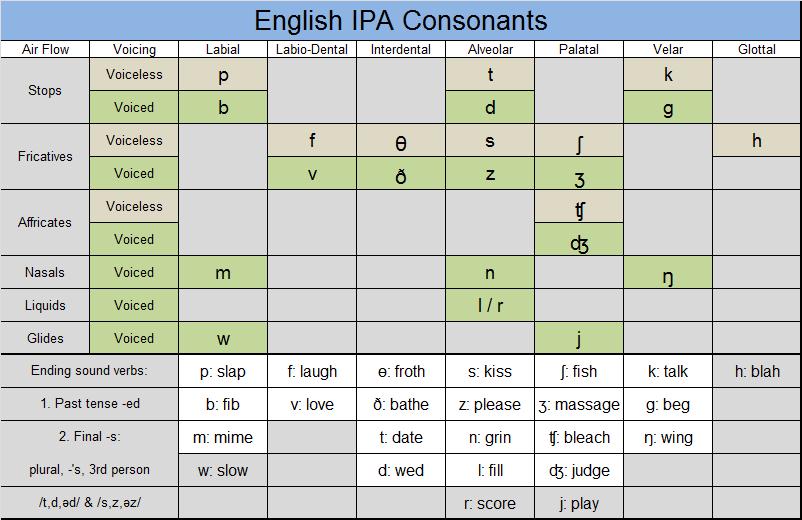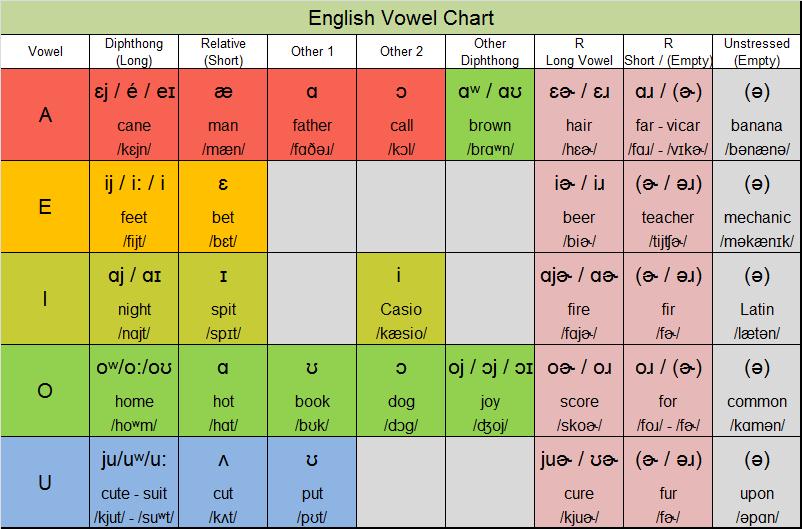Confusing though it may appear at first, the IPA was created to make sense out of the multitude of sounds an writing systems seen in the worlds' languages. While this system was meant to dispell any ambiguity in the way that a word is pronounced, many dictionaries use varying forms of the IPA.
The CONSONANTS are fairly straight foward. Pay attention to whether a consonant is voiced or voiceless.
**The GLIDES /w/ and /j/ are consonants at the begining of a syllable and vowels at the end, so they appear in both charts.
**The LIQUID /r/ is one of the most difficult sounds to master in English, especially for learners whose native tongues come from a variety of Asian languages. Your host asserts that the ending /r/ sound is a VOWEL, not a consonant. Therefore, it also appears on both charts. When this sound follows a vowel, it often alters or 'stains' the sound of that vowel, similar to the way that washing something red with your white clothes will turn them pink.
The VOWELS in my usage of the IPA have been formulated to conform with the standard North American dialect. Please recognize that each dialect of English uses its own pronunciation of these vowels. I have chosen to use the glides /w/ and /j/ with each of the long vowels to emphasize the nature of the diphthong as well as to lay clear the linking sound that may result with succeeding words or syllables.
**Be aware that the variation of IPA employed in your own dictionaries may differ from the IPA that is displayed here. This is mainly true for the vowels only. Choose the system that works best for you and stick to it. You will find that using the IPA can truly help you to make sense out of English pronunciation.
The CONSONANTS are fairly straight foward. Pay attention to whether a consonant is voiced or voiceless.
**The GLIDES /w/ and /j/ are consonants at the begining of a syllable and vowels at the end, so they appear in both charts.
**The LIQUID /r/ is one of the most difficult sounds to master in English, especially for learners whose native tongues come from a variety of Asian languages. Your host asserts that the ending /r/ sound is a VOWEL, not a consonant. Therefore, it also appears on both charts. When this sound follows a vowel, it often alters or 'stains' the sound of that vowel, similar to the way that washing something red with your white clothes will turn them pink.
The VOWELS in my usage of the IPA have been formulated to conform with the standard North American dialect. Please recognize that each dialect of English uses its own pronunciation of these vowels. I have chosen to use the glides /w/ and /j/ with each of the long vowels to emphasize the nature of the diphthong as well as to lay clear the linking sound that may result with succeeding words or syllables.
**Be aware that the variation of IPA employed in your own dictionaries may differ from the IPA that is displayed here. This is mainly true for the vowels only. Choose the system that works best for you and stick to it. You will find that using the IPA can truly help you to make sense out of English pronunciation.
IPA Consonants & Vowels as they are used in Albert's English Courses.


Foreign IPAs


These IPA charts may differ from those on the GMU website and some have additional orthography samples.











